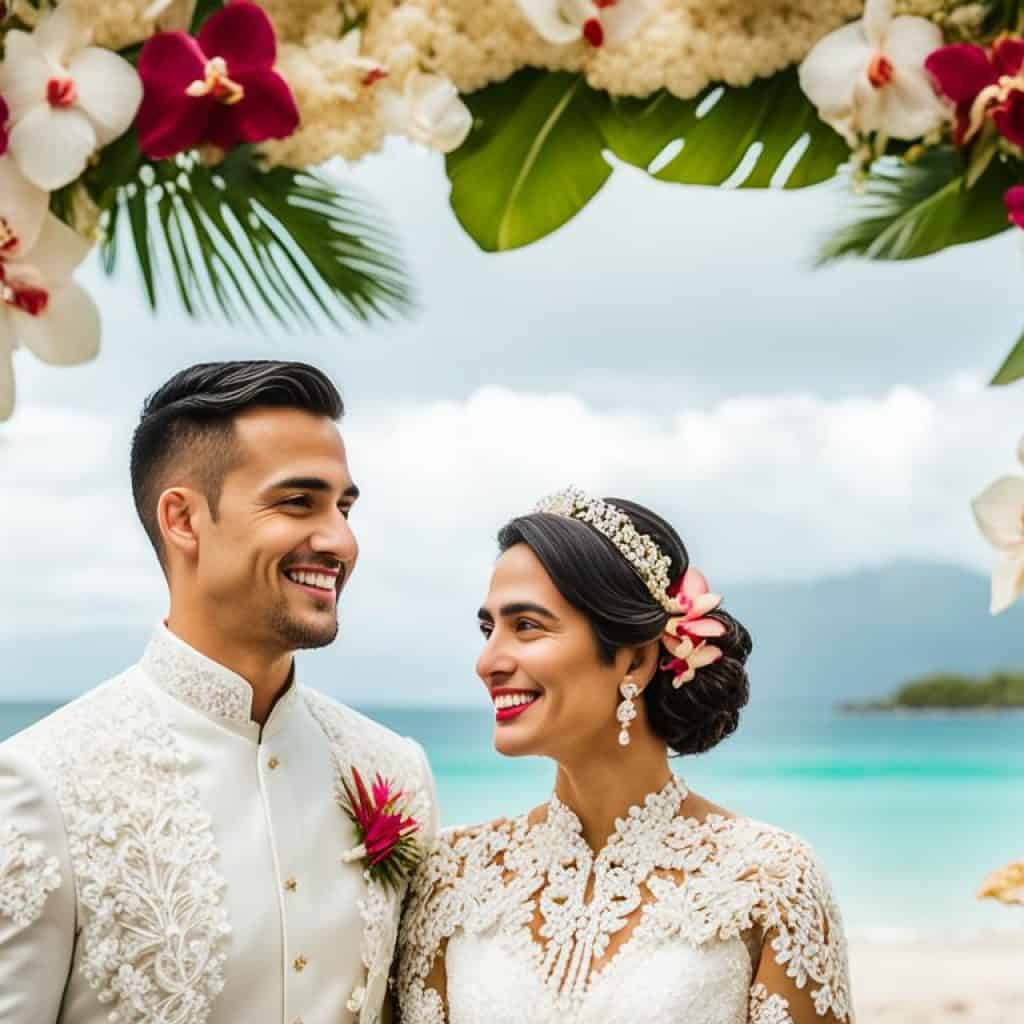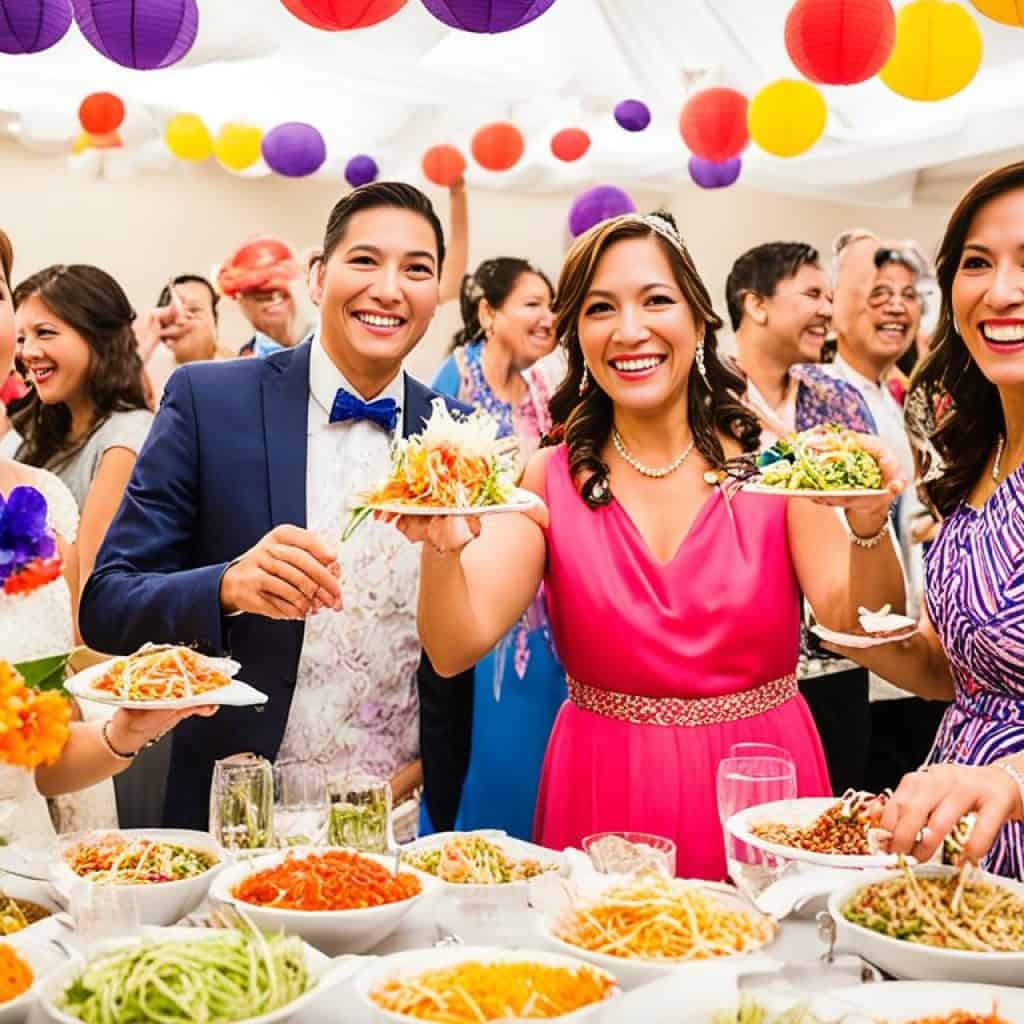Ever thought about the rich culture in a traditional Filipino wedding? It’s more than just white gowns and tuxedos. These celebrations show off the Philippines’ diverse heritage1. They mix old and new, inviting you to see the beauty and meaning behind these customs.
Key Takeaways
- Filipino weddings mix modern and historic traditions, showing the country’s diverse culture.
- Family and parental blessings are very important in Filipino weddings.
- Ceremonies like the unity candle, coin exchange, and cord rituals have deep meanings.
- Traditional clothes like the Barong Tagalog and Filipiniana dress make the wedding more elegant.
- Beliefs and superstitions, like the importance of rain on the wedding day, are part of Filipino marriage traditions.
Introduction to Filipino Wedding Customs
The Philippines, with over 7,000 islands, is a place of diverse cultures. Each island has its own special way of celebrating weddings2. While many weddings follow Catholic traditions, others have their own unique ways to honor their heritage2. At the heart of every Filipino wedding is the value of family and community, making the celebration a big deal for everyone involved.
The Diverse Roots of Filipino Weddings
Philippine weddings reflect the country’s rich cultural mix3. The Ifugao people’s Takik dance and the Islamic Nikah ceremony show the variety of traditions across the country3. Each group has its own special way of celebrating, adding to the country’s wedding culture.
The Importance of Family and Community
Family and community are key to Filipino weddings2. The tradition of Pamanhikan, or the formal marriage proposal by parents, shows how important family is in the wedding2. Having multiple sponsors, or Godparents, also highlights the support system for the newlyweds2.
“Filipino weddings are not just about the bride and groom; they are a celebration of the coming together of two families and the entire community.”
This quote sums up Filipino weddings well. It’s not just about the couple; it’s about the union of two families and the community4. From the food to the performances, every part of a Filipino wedding shows the deep connection to heritage and belonging243.
The Engagement: Kasunduan and Pamamanhikan
In the vibrant world of Filipino marriage traditions, the engagement is a big deal. It’s called Kasunduan. The couple wears rings to show they’re committed to each other5.
The Pamamanhikan ceremony is the first big step. Here, the groom-to-be tells the bride’s family he wants to marry her and asks for their blessing6. This tradition is all about sharing plans and getting family approval. It’s very important in Filipino culture because family and community matter a lot6.
Expressing Intentions and Seeking Blessings
The Pamamanhikan ceremony is a big deal in the engagement process. The groom-to-be and his family bring gifts, called pasalubong, to the bride’s family. This shows they respect and are serious6. Then, they talk about the couple’s future, like the budget and who to invite7.
This meeting is key. The groom asks the bride’s family for her hand in marriage. He wants their blessing6. The bride being a bit hard to get is also part of the tradition. It shows she’s modest and graceful6.
The Kasunduan and Pamamanhikan traditions prepare the couple for their life together. They highlight the value of family, community, and understanding in marriage567.
Preparing for the Big Day
Planning your filipino wedding is exciting. Choosing the right venue and date, and adding traditional filipino wedding decor, makes the day unforgettable8.
Selecting the Venue and Date
The venue you pick shows your unique story and cultural roots. Many filipino couples choose a church, community center, or courthouse for their wedding9. They avoid Tuesdays and Fridays because of superstitions. Instead, they pick days believed to bring luck and wealth10.
Decorating with Traditional Elements
Adding filipino wedding decor makes the celebration special and personal. Using banig (woven mats) and local baskets, and choosing vibrant filipino flowers, honors your cultural background9. It’s also a way to show pride in your heritage by using filipino-made materials and decorations9.
“The decor choices can pay homage to the couple’s cultural background.”
Choosing the right venue, date, and traditional filipino wedding decor makes your celebration authentic and memorable. It shows off your filipino heritage8910.
Choosing Wedding Attire
When it comes to Filipino wedding fashion, traditional attire is key. As you plan your big day, you’ll get to show off the Philippines’ rich culture through your clothes11.
The Barong Tagalog for Grooms
The Barong Tagalog is a must-have for Filipino grooms. It’s a light, detailed shirt that looks great over an undershirt. It’s both timeless and elegant, starting at 1,999 pesos11.
The Filipiniana Dress for Brides
The Filipiniana dress is a beautiful choice for brides. It’s a two-piece set with butterfly sleeves and detailed embroidery. You can find it in styles like the classic Alampay or the modern Puffed Sleeves Bolero. A full set costs about 1,700 pesos, making it budget-friendly11.
Many modern brides also pick white gowns with Filipino touches. This mix of old and new lets them celebrate their culture and look beautiful on their big day12.

“The Barong Tagalog and Filipiniana dress are more than just clothes – they symbolize our rich cultural identity, part of our most important celebrations.”13
Whether you go for traditional or modern, your wedding clothes will show off Filipino fashion’s beauty and diversity111312.
The Wedding Sponsors (Ninongs and Ninangs)
In Filipino weddings, Ninongs and Ninangs are key players. They join the bride and groom in prayers, acting as witnesses and supporters14.
Choosing these sponsors shows the couple’s values and their importance to community and tradition14. Often, there are two main sponsors who sign the marriage certificate14. Secondary sponsors can be close friends or family14.
These ceremonies include candle, coins, cord, and veil ceremonies14. When picking sponsors, couples look for trust, guidance, and support14. Usually, there are two main and two secondary sponsors for each ceremony14.
Ninongs and Ninangs do more than just take part in the ceremony. They might give money to the wedding and offer advice and support to the couple14. The number of sponsors depends on the wedding size, but they’re chosen for their trustworthiness14.
For a legal wedding, you need at least two sponsors, but traditional weddings often have more15. Ninongs and Ninangs are chosen for their wisdom and role as a second set of parents15.
The number of sponsors can vary, from 8 in small weddings to 16 in big ones15. Some churches limit the number of sponsors15.
The ratio of Ninongs to Ninangs to couples varies widely16. Often, they are relatives or friends of the parents, and couples choose people they know well16.
Many Ninongs and Ninangs give gifts to the couple, and couples visit them before the wedding16. The number of Ninongs and Ninangs can vary, with more Ninangs chosen16.
“The wedding sponsors, or Ninongs and Ninangs, play a significant role in providing support and guidance during the nuptials and throughout the couple’s marriage.”
The Ceremony Rites and Rituals
Filipino wedding ceremonies often include Catholic-influenced rituals that are very important. These traditions, like the Candle Ceremony, the Unity Veil and Cord Ceremonies, and the Coin Ceremony (Arras), show the couple’s commitment and the blessings they receive17.
The Candle Ceremony
The Candle Ceremony symbolizes the bond between two people and their families. The couple lights a single candle together, showing their love and devotion17. In Filipino culture, if a candle goes out, it means the person next to it might die before their partner18.
The Unity Veil and Cord Ceremonies
The Unity Veil and Cord Ceremonies show the couple’s unity and wish for health and protection. The veil covers the couple, symbolizing their life together. The cord, in a figure-eight shape, means their eternal bond17. These rituals are done by the wedding sponsors, who are key in the ceremony18.
The Coin Ceremony (Arras)
The Coin Ceremony, or Arras, is a big part of Filipino weddings. The groom gives the bride 13 blessed coins, promising to take care of their future family17. This tradition goes back to before colonial times, when the groom threw his spear at the bride’s home steps to show his intentions19.
These rituals honor the couple’s commitment and show the rich culture of the Filipino people. When planning your Filipino wedding, include these traditions for a memorable celebration.
Filipino Marriage Traditions
Filipino marriage traditions show the mix of cultures that have shaped the Philippines. These traditions come from Indigenous roots, Spanish rule, and American influence20. They highlight the country’s rich history and heritage20. Customs like the Kagen & Taltag in Mindanao and the Ting Hun in Filipino-Chinese weddings are full of deep meaning20.
Today, Filipino couples, even those living abroad, keep their cultural traditions alive1. They blend Western touches with their heritage in their weddings1. The Panliligaw And Pamamanhikan, a formal courtship, is still seen in some weddings, especially in rural areas1. Getting parents’ blessings is key, showing respect and acceptance of the couple1.
Many old traditions are still part of today’s weddings, like the cord and veil ceremony for unity1. The 13 coins given during the ceremony mean prosperity and a promise to support each other1. The unity candle ceremony is also a beloved tradition, symbolizing the joining of two families and souls1.
Some old customs, like bulungan and bayanihan, are less common now, but family and community involvement is still big in Filipino weddings1. Wedding receptions, or Handaan, have changed from just rice cakes to include many foods, including Western and local dishes1.
There’s a push to keep Filipino wedding traditions alive through festivals, education, and documentaries20. By mixing old and new, couples make weddings that respect their heritage and reflect their own tastes and the times1.
The Handaan: Filipino Wedding Reception
The Filipino wedding reception, known as the Handaan, is a lively celebration of the couple’s union21. Traditionally, Filipino weddings lasted three days, filled with rituals like the blessing of rice grains and the binding of the couple21. Now, they’ve simplified, mixing old customs with new traditions21.
Traditional Filipino Wedding Menu
The Handaan serves dishes like lechon (roasted suckling pig), pancit (noodle dishes), and sweets like sapin-sapin and ube21. Today’s receptions often mix traditional foods with Western tastes21.
The Money Dance Tradition
The Money Dance is a big part of Filipino weddings. Guests pin money on the couple as they dance, wishing them luck and financial success21. It’s a way for guests to give the couple money for their future22.
Throwing rice grains at the newlyweds means they’re wished good luck and prosperity21.

“The Handaan is more than just a wedding reception; it’s a celebration of the couple’s love, the joining of families, and the rich cultural heritage of the Philippines.”23
Incorporating Cultural Elements
Planning your Filipino wedding is a great chance to honor your heritage. Adding cultural elements makes the day special for you and your guests24.
Music and Dance Performances
Filipinos love their music and dance. Think about getting a local Filipino band for your reception24. The Tinikling or Sayaw sa Bangko dance can add a real touch to your celebration24. These dances will make your event unforgettable for your guests.
Gifts and Favors for Guests
Gifts and favors are another way to share your culture. Traditional abanikos fans are a unique and useful favor24. You could also give out pamoranos or puto as symbols of your heritage24.
Adding these elements to your wedding makes it truly special and connected to your roots24. Your guests will love learning about and experiencing your culture, making your day even more memorable24.
“Embracing your cultural traditions is a wonderful way to make your wedding day truly special and unique.”
Honoring Your Heritage
Planning a Filipino wedding is a chance to celebrate your culture and mix old and new traditions. It’s a way to show your love story and values25. Filipinos love their weddings, making them a big deal. By picking the right rituals, you can make your wedding meaningful and personal.
Wedding traditions in the Philippines are very important. They show the joining of two lives and families26. The Veil + Cord symbolizes two souls becoming one. The Unity Candle lighting shows the coming together of two families26. The 13 Coins, or Arrhae, stand for wealth and helping each other financially, with the groom giving them to the bride.
Blending Customs and Creating New Traditions
You can update classic Filipino ceremonies or start new ones to celebrate your love and heritage27. One couple mixed Filipino and Jewish traditions, adding a Filipino money dance and a Jewish hora dance to their ceremony.
25 Throwing rice after the wedding wishes the couple luck and happiness. The barong tagalog, a traditional Filipino outfit, is often worn by men. Mixing these traditions with your own ideas makes your wedding special and meaningful.
27 The couple had to delay their wedding because of the pandemic. They used the time to plan a celebration that honored their heritage and showed their style and values.
“We wanted our wedding to be a true reflection of who we are as a couple, but also to pay tribute to our families’ cultural traditions. By blending the Filipino and Jewish elements, we were able to create a celebration that was both meaningful and joyful.”
Embracing your heritage and starting new traditions makes a Filipino wedding special25. The veil and cord in the ceremony stand for unity and love. By honoring your roots and adding personal touches, your wedding will reflect your culture and love story.
Filipino Marriage Statistics and Requirements
Thinking about a Filipino wedding? It’s key to know the stats and legal rules around marriage in the Philippines28. The Philippines is diverse, showing in its marriage data and laws.
In 2019, there were 431,972 marriages, fewer than the year before28. But 2022 saw a jump, with 449,428 marriages, a 25.9% increase29. The marriage rate also went up to 4.0 per thousand people in 2022, from 3.2 in 202129.
The top three regions for marriages in 2019 were CALABARZON, NCR, and Central Luzon28. CALABARZON led again in 2022 with 63,838 marriages, making up 14.2% of all29.
December is the top month for weddings, with 44.9% in 201928. It stayed the top month in 2022, with 55,599 marriages29.
The average age for marriage was 27 for women and 29 for men in 201928. In 2022, the most common age group was 25 to 29, with a big difference in the number of young women and men getting married29.
Most marriages in 2019 were civil ceremonies, followed by Roman Catholic and other religious rites28. In 2022, civil ceremonies were still the most common, with a slight increase in Roman Catholic ceremonies29.
Most marriages in 2019 were between Filipino couples, with a small number involving foreign nationals28. This was similar in 2022, with a slight increase in intermarriages with foreign partners29.
Common partners for Filipino men were American, Australian, Canadian, Chinese, and Japanese women28. For Filipino women, the top partners were American, Japanese, British, Korean, and Canadian men28.
Legal rules for marriage in the Philippines are strict for both locals and foreigners30. You’ll need to prepare documents and follow certain steps for a valid marriage in the Philippines.
Knowing about Filipino marriage stats and rules helps couples plan a meaningful wedding. It’s important for both Filipino citizens and those marrying Filipinos. Being informed makes your marriage journey smoother and happier.
Marrying a Beautiful Filipina
The Philippines is full of beautiful and culturally rich filipino brides and filipina women. For those interested in interracial filipino marriage, it can be very rewarding. Filipina women are known for their warmth, family values, and beauty31.
When looking to marry a Filipina, understanding their culture and legal requirements is key. It’s also important to respect their heritage and background. The process includes looking at the couple’s finances, cultural fit, and the Filipina’s goals and preferences31.
Thinking about the cost is a big part of marrying a Filipina. Online dating can save money, but it can still be expensive. The average cost for a trip to the Philippines is about $3,00031. It’s also important to know the laws in the Philippines, like Republic Act №10906, which protects Filipinos from mail-order bride scams31.
Despite the costs and legal rules, marrying a Filipina has many rewards. The Philippines has a low divorce rate, at 1.8 divorces per 1,000 people31. Also, dating websites have a 96.6% success rate in matching American men with Filipino brides31. With the right approach, a lasting and fulfilling relationship is possible.
“The Philippines is a land of beauty, tradition, and warm-hearted people. Marrying a Filipina can be a truly rewarding experience, but it’s important to approach it with respect, patience, and a willingness to learn about the rich cultural heritage.”
Marrying a Filipina means valuing their unique culture and traditions. By embracing these, couples can build a strong and lasting bond32.
The process of marrying a Filipino woman includes meeting online, getting visas, and dealing with cultural differences33. Filipino women usually get married at 21.6 years old and have their first child at about 2333. Knowing these cultural facts helps couples prepare for any challenges they might face.
In conclusion, marrying a Filipina is rewarding but requires understanding and respect for their culture and laws. By valuing Filipino traditions, couples can build a strong and fulfilling relationship33.
Conclusion
Filipino weddings mix old and new customs in a big celebration of love, family, and community. The Philippines has over 7,000 in Southeast20. Its culture shows in the many wedding traditions that have grown over time. These traditions were shaped by Spanish rule and the spread of Catholicism2034.
You can add old rituals like the Candle Ceremony and the Money Dance20 to your wedding. Or, you can make new traditions that tell your own story. Knowing the roots of these customs helps you plan a wedding that honors your love and culture34.
When planning a Filipino-inspired wedding, dive into the rich traditions. Make your celebration unique and reflect the vibrant culture that has shaped your life. The Philippines has many cultural areas with their own wedding customs20. By celebrating this diversity, you’ll have a wedding that’s unforgettable and meaningful, loved for years to come.
FAQ
What are the key features of Filipino wedding traditions?
How do Filipino weddings incorporate the importance of family and community?
What are the key traditions in the Filipino engagement process?
How do Filipino couples choose the venue and decor for their wedding?
What are the traditional Filipino wedding attire options?
What is the role of wedding sponsors (Ninongs and Ninangs) in Filipino weddings?
What are the key rituals and ceremonies in a Filipino wedding?
How do Filipino marriage traditions reflect the country’s diverse cultural influences?
What are some of the highlights of a Filipino wedding reception (Handaan)?
How can couples incorporate Filipino cultural elements into their wedding celebration?
What are the key considerations for couples planning a Filipino wedding?
What are the important statistics and requirements surrounding Filipino marriages?
Source Links
- https://www.theknot.com/content/cultural-traditions-philippines
- https://en.wikipedia.org/wiki/Marriage_and_wedding_customs_in_the_Philippines
- https://www.filipinowedding.com/pages/filipino-wedding-traditions
- https://www.linandjirsa.com/filipino-wedding-traditions/
- http://weddingsinthephilippines.com/filipino-wedding-traditions/
- https://www.filipinowedding.com/blogs/wedding-blog/traditions-of-courtship-engagement-in-the-philippines
- https://businessmirror.com.ph/2015/06/20/getting-hitched-the-filipino-way/
- https://barongworld.com/blogs/news/the-filipino-wedding-guide-barongworld
- https://www.filipinowedding.com/blogs/wedding-blog/the-first-5-steps-to-plan-your-filipino-wedding
- https://www.provenance.co/post/filipino-wedding-traditions-a-comprehensive-guide
- https://thebudgetarianbride.com/the-ultimate-filipiniana-attire-guide/
- https://barongsrus.com/10-filipino-wedding-traditions-and-practices-you-should-know-about/
- https://www.weddedwonderland.com/15-filipino-wedding-traditions-you-wont-believe/
- https://www.filipinowedding.com/blogs/wedding-blog/how-to-choose-filipino-wedding-sponsors-ask-yourself-these-3-important-questions
- https://www.nuptials.ph/wedding-ninangs-and-ninongs/
- https://brideandbreakfast.ph/2022/12/16/choosing-principal-sponsors/
- https://sergeygreen.com/filipino-wedding-traditions/
- https://weddedwonderland.com/15-filipino-wedding-traditions-you-wont-believe/
- https://weddingsatwork.com/filipino-wedding-customs/
- https://barongworld.com/blogs/news/filipino-wedding-traditions-a-tapestry-of-culture-and-love
- https://www.filipinos2meet.com/blog/filipino-traditional-wedding/
- https://doggietrail.wordpress.com/2011/02/09/flip-wedding-factoids/
- https://weddingsatwork.com/glossary-of-kasal/
- https://iltulipano.com/how-to-incorporate-cultural-traditions-into-your-modern-wedding/
- https://www.townsdelight.com/blog/10-popular-filipino-wedding-traditions
- https://milbesoscostarica.com/filipino-wedding-traditions/
- https://www.out.com/weddings/2022/4/15/how-jewish-and-filipino-cultures-combined-perfect-wedding
- https://psa.gov.ph/content/2019-philippine-marriage-statistics
- https://psa.gov.ph/statistics/vital-statistics/node/1684061650
- https://www.philstar.com/headlines/2023/02/17/2245649/census-more-filipino-couples-now-live-arrangements
- https://dorisdating.medium.com/filipino-women-looking-for-marriage-8c314b783520
- https://www.expatforum.com/threads/i-brought-my-filipina-spouse-to-the-us-to-get-married-now-she-doesnt-want-to-go-back-to-the-philippines.1538771/
- https://medium.com/inspirationalwomenseries/things-to-know-before-marrying-filipino-woman-7fe25e69d5e8
- https://barongworld.com/blogs/news/the-rich-tapestry-of-philippine-marriage-culture-traditions-values-and-evolution







Add comment